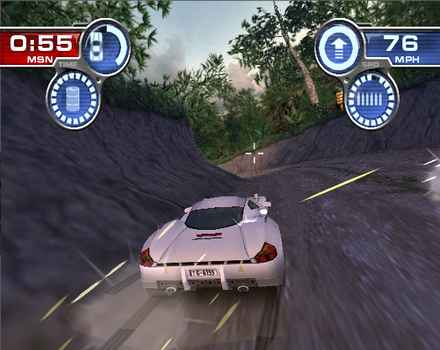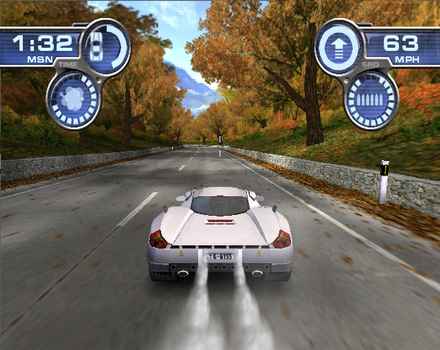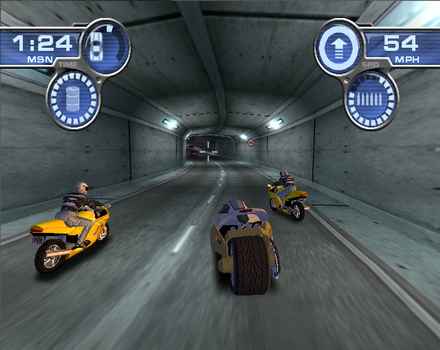The legendary 1980ís arcade hit Spy Hunter has
returned on the PS2 thanks to Midway. This version of Spy Hunter comes complete
with a huge graphics and gameplay facelift that sets it firmly in the
contemporary gaming arena. While the title takes its inspiration and many of its
basic mechanics from the original, there are so many upgrades and changes to the
formula that it almost feels like a new game. However, the essence of the
original is still very much evident in this version. There are a few minor
problems, the biggest being the overly dark graphics, but are these flaws enough
to spoil the experience? We take a look at this neo-classic title and find out.
While many updates of classic games are mere shadows of
their inspirations (see the many lame attempts Hasbro made at updating Atari
titles such as Pong and Missile Command for good examples of exactly how not to
update a well-loved title), Midway hasnít taken that path with this release.
Instead this is an intelligently updated version of Spy Hunter that really
captures the flavor of the original but donít worry if you havenít played
the original. Fans of the original will initially be shocked that the sequel
takes place in a complete 3D environment and how many new elements there are to
the game but the classic "Peter Gunn" theme music is there for a
nostalgic touch to reassure the fans of the original. The gameplay is still
fairly close to the original: Youíre a lone spy in a suped-up Interceptor,
battling enemy vehicles as you try and fight the evil counter-terrorist
organization looking to set the world back to the Stone Age. The modern
environments seem a bit odd at first, but then you see a few familiar elements
such as the red vans. Some of the changes are quite impressive, such as the way
the vehicle strips down to a motorcycle when you take a lot of damage. There are
also some new weapons such as lock on missiles in addition to the old standbys
such as the smoke-screen, black oil and of course, the classic Spy Hunter
machine guns. These new elements fit in well with the original game mechanics to
greatly enhance the familiar play mechanics without ruining the overall feel of
the game.
 Spy
Hunter has evolved significantly in the PS2 edition with a much more
sophisticated feel than the original had. Instead
of the single long, linear mission, there are now a series of smaller
sub-missions to get through. Each mission has a main objective that needs to be
completed. These missions are further split into primary and secondary
objectives to complete and you need to complete as many of these as possible,
since each one gives you a point that can unlock new missions. The missions
themselves are quite varied with plenty of surprises and challenges throughout
that will definitely challenge the players. There are new enemies such as
helicopters, missile installations and hovercraft which are more numerous
throughout the levels, all with their guns aimed squarely at your interceptor.
Theyíre significantly smarter and hell-bent on making completing all the
objectives in each mission difficult. Youíll also have to watch out for mines
and, as in the original game, avoid inflicting damage on innocent bystanders
which is a sub-objective in each level Ė failing to do this will cause you to
lose critical objective points and makes unlocking later levels difficult.
Luckily, the new edition still has simple, tight and intuitive controls though
theyíre more elaborate.
Spy
Hunter has evolved significantly in the PS2 edition with a much more
sophisticated feel than the original had. Instead
of the single long, linear mission, there are now a series of smaller
sub-missions to get through. Each mission has a main objective that needs to be
completed. These missions are further split into primary and secondary
objectives to complete and you need to complete as many of these as possible,
since each one gives you a point that can unlock new missions. The missions
themselves are quite varied with plenty of surprises and challenges throughout
that will definitely challenge the players. There are new enemies such as
helicopters, missile installations and hovercraft which are more numerous
throughout the levels, all with their guns aimed squarely at your interceptor.
Theyíre significantly smarter and hell-bent on making completing all the
objectives in each mission difficult. Youíll also have to watch out for mines
and, as in the original game, avoid inflicting damage on innocent bystanders
which is a sub-objective in each level Ė failing to do this will cause you to
lose critical objective points and makes unlocking later levels difficult.
Luckily, the new edition still has simple, tight and intuitive controls though
theyíre more elaborate.
A bit of a deeper explanation of the gameís controls is in order because there
are a lot of new elements to master. Driving is still pretty straightforward, so
donít expect anything like Gran Turismo. However, the weapons and stunts need
a lot of practice before theyíre mastered. A few laps around the training
course should give you a good feel for how the game controls, but true mastery
of the game involves much more. Firstly, you need to know when to switch from
the machine guns to the more powerful missiles, and this is another choice.
There are two types of these Ė standard missiles are ground-based and shoot in
a straight line from the position at which you fired. Homing missiles take a bit
more effort since they need to be targeted to be effective Ė youíll need to
press down on the left-analog stick in order to accomplish this, which can be a
pain when youíre in the heat of battle and the awkward interface here is a
real problem that makes it difficult to fire without wasting missiles. This is
mainly because you need to do this in the heat of battle, making precise
targeting extremely difficult Ė you basically have to clear each area before
you can target the bigger objectives in each level. Another element you need to
worry about are the targets which need to be tracked, which means you have to
fire satellite tracking devices on them. This is easy to accomplish, but you
absolutely need to be more careful since the interface is a bit confusing and
its not impossible to accidentally destroy a target you only needed to place the
tracking beacon on. Despite all these problems, the game still controls well for
the most part, but there are points when Spy Hunterís interface seems to be
needlessly clunky and gets in the way of the gameplay. A real shame, since some
of this seems to be a little excessive and streamlining one or two function
commands into a single key press would have made things much more enjoyable. Spy
Hunterís controls arenít perfect but unfortunately, this isnít the gameís
biggest problem.
 Spy
Hunterís biggest flaw lies in its difficulty, which is more than excessive and
borders on sadistic. Itís not just that the objectives are difficult to
complete, itís because it takes several attempts at each mission to complete
all the objectives successfully, and some of the objectives are extremely
difficult to complete in themselves, but there are others that need to be
completed simultaneously. This is an almost impossible task because while you
are credited with completing the primary objective, if you complete secondary
objectives without completing the main task, you donít get credit for those
efforts. This can get enormously frustrating as you can imagine and really hurts
the long-term appeal. The fact that you also have to complete all these
objectives in a ridiculously short amount of time in order to unlock some of Spy
Hunterís secret areas and bonus features is another really aggravating thing
that hurts the titleís appeal. Most players will just have to wait for the
cheats to come out or buy a GameShark, though with persistence, some will be
able to get through the title without cheating. What really makes this worse is
that he missions are extremely long and a single stupid mistake towards the end
means you have to start over from the beginning. This means completing Spy
Hunterís missions will take a very long time. Itís an open question as to
how many will want to play this all the way through since itís supposed to be
a simple arcade title, not an RPG. Putting all that aside, the game is fun for
the most part and while it can get frustrating, itís still not too terrible if
you have a lot of patience.
Spy
Hunterís biggest flaw lies in its difficulty, which is more than excessive and
borders on sadistic. Itís not just that the objectives are difficult to
complete, itís because it takes several attempts at each mission to complete
all the objectives successfully, and some of the objectives are extremely
difficult to complete in themselves, but there are others that need to be
completed simultaneously. This is an almost impossible task because while you
are credited with completing the primary objective, if you complete secondary
objectives without completing the main task, you donít get credit for those
efforts. This can get enormously frustrating as you can imagine and really hurts
the long-term appeal. The fact that you also have to complete all these
objectives in a ridiculously short amount of time in order to unlock some of Spy
Hunterís secret areas and bonus features is another really aggravating thing
that hurts the titleís appeal. Most players will just have to wait for the
cheats to come out or buy a GameShark, though with persistence, some will be
able to get through the title without cheating. What really makes this worse is
that he missions are extremely long and a single stupid mistake towards the end
means you have to start over from the beginning. This means completing Spy
Hunterís missions will take a very long time. Itís an open question as to
how many will want to play this all the way through since itís supposed to be
a simple arcade title, not an RPG. Putting all that aside, the game is fun for
the most part and while it can get frustrating, itís still not too terrible if
you have a lot of patience.
Midway deserves a lot of credit for making an effort at
bring the series fully into the 21st century with state-of-art
production values and a good graphics engine. This approach is only enhanced by
the super-slick menus, cinemas and computer voice-overs which combine to make
Spy Hunter feel modern and fresh instead of being some watered down rehash. The
visuals are for the most part crisp and clear with most objects quite visible
and the variety of locales included in the game should give players plenty of
inspiration to keep playing. Unfortunately, there are some areas which are too
dark, overall and this lack of visibility is very annoying Ė this is
especially apparent in the water based levels and in some of the tunnels. Itís
also difficult to tell the enemy vehicles apart from the civilian cars, which
means youíll cause damage to a lot of innocent bystanders. On the bright side,
Spy Hunter runs at a very fast frame-rate and the action is blisteringly intense
for the most part. The most impressive thing about this update is how the
developers have developed a back-story that ties in the new edition into the
previous titles so effectively.
 Some
of the problems with the game might seem a bit picky but are annoying
nonetheless. Spy Hunter takes the essence of the classic arcade game and
modernizes it so much as to make its lineage almost a non-issue. The biggest
problem with the new title is the excessive complexity of its controls and the
difficulty in completing all the objectives in a single run. Still, its mix of
hard-core action should appeal to contemporary gamers looking for an arcade
gaming fix who donít mind a challenge. Fans of the original Spy Hunter might
not recognize it under all the new layers of graphic frills, itís still Spy
Hunter. Despite its flaws, this is a challenging title. Perhaps too challenging
for its own good but at least you wonít beat it in one sitting, which is more
than you can say for a lot of other neo-classic releases recently. This is an
above-average classic update that mostly succeeds in its mission of updating the
series while adding new elements.
Some
of the problems with the game might seem a bit picky but are annoying
nonetheless. Spy Hunter takes the essence of the classic arcade game and
modernizes it so much as to make its lineage almost a non-issue. The biggest
problem with the new title is the excessive complexity of its controls and the
difficulty in completing all the objectives in a single run. Still, its mix of
hard-core action should appeal to contemporary gamers looking for an arcade
gaming fix who donít mind a challenge. Fans of the original Spy Hunter might
not recognize it under all the new layers of graphic frills, itís still Spy
Hunter. Despite its flaws, this is a challenging title. Perhaps too challenging
for its own good but at least you wonít beat it in one sitting, which is more
than you can say for a lot of other neo-classic releases recently. This is an
above-average classic update that mostly succeeds in its mission of updating the
series while adding new elements.

